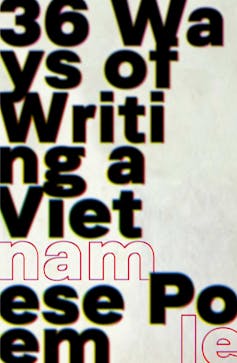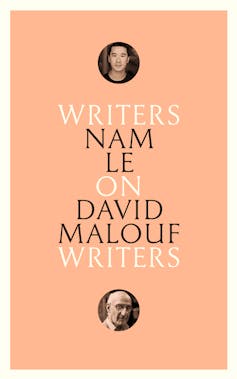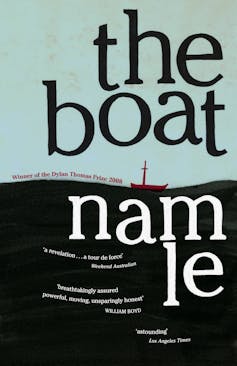Flying in the face of much contemporary poetry, Nam Le’s first collection 36 Ways of Writing a Vietnamese Poem is defiantly cerebral, relishing the polysyllabic, the latinate and the esoteric. This is not to say that there aren’t notes of utter beauty and great feeling, just that Le is not afraid of being difficult. The difficulty is part of the collection’s aesthetic.
In an interview, Le said that he dreamed his work could sustain a “cold read” as easily as an “academic assault”. These are severe yardsticks for a poet to write by, so it is little wonder that his poems are exacting, sometimes peremptory in tone.
Review: 36 Ways to Write a Vietnamese Poem – Nam Le (Simon & Schuster)
Underlying even the most comic or lyrical of moments in the book is a seriousness and a woundedness that tips into anger and sorrow. Because the poetry is meticulous and skilled – the work of a poet who has lived with poetry for the longest time – the anger, the woundedness and the sorrow are directed and purposeful, not confessional, not easily sincere or authentic.
With poem titles including [16. Violence: Autologous], [18. Inter-Analectional] and [30. Asymptotic], there is no quick or easy reading. The square brackets suggest domains outside of poetry – linguistics, coding, mathematics – but brackets also embed a phrase or idea more deeply within a sentence or an already parenthetical idea.
The effect is of a mise en abyme – an infinite regression – that resists the impulse to classify and order. The bracketed and numbered titles make the process of referencing a poem from the collection, whether in a review or elsewhere, more laborious and exacting. This is a kind of play – serious play, but play nonetheless.
That each title is adjectival is a reminder that each poem refers outwards. It is not an end, but a “way” to a larger poem – perhaps but not necessarily the elusive, impossible Vietnamese poem of the title.
Imagination, emotion, intellect
Nam Le has won prestigious and lucrative prizes. He studied at Harvard, where he was fiction editor of the Harvard Review, and has published a book on David Malouf as part of Black Inc.’s “writers on writers” series.
But he is best known as the author of The Boat, a collection of short stories that includes the award-winning eponymous story about Mai, a young girl who is smuggled out of Vietnam.
The story was written beautifully and viscerally enough to find itself on reading lists of universities and schools, nationally and overseas. In its scope and language, The Boat drew something mythic from the short story form. Perhaps this had something to do with Le’s disregard for length – at 40 pages, it’s a long short story – or perhaps it was because his driving narrative prose dipped into the rhythms and imagery of poetry.
The Boat was a story that captured the imagination, harnessing the historical and the political, but ultimately rendering these realities secondary to the work that art does. If transcendence is too vexed a term, then Le’s story might be said to transform the reader, at least temporarily, into a being concerned with existence, with the business of being human in a fallen world.
In pitting the frail singularity of a child against the forces of war and border politics, The Boat appeals to the emotions. 36 Ways of Writing a Vietnamese Poem, with its insistence on the constructedness and the materiality of language – both as sound and writing – appeals to the intellect.
André Dao’s brilliant debut novel explores his grandfather’s ten-year detention without trial by the Vietnamese government
Ways and means
To ask whether this book is a collection of poems or a single long “Vietnamese” poem is to step through the looking glass, where an entity called “You” looms large, and meanings and associations become slippery.
Read as a book-length poem, 36 Ways to Write a Vietnamese Poem has an almost overdetermined chronological structure. Narratively speaking, it starts at the beginning and ends at the end.
The first poem, [1. Diasporic], is too stylised to be read as straightforwardly autobiographical. But when Le posits it as the first “way” to write a Vietnamese poem, he plays on his origins and the “dynamic borderline” (as Jacques Derrida puts it in The Ear of the Other), between a writer’s life and their work.
The book ends with a 37th poem, implying that one poem in the collection does not constitute a “way”. [37. Post-racial/-glacial] is ecopoetic. It is an exercise in speculative futurism that imagines a post-racial world – something that may be the furthest thing now imaginable. The “glacier” is the addressee, but it is also an image, symbol and metaphor – of climate catastrophe, geological timeframes, and the “sediments” of page and self.
[1. Diasporic] opens with parody, a deep-throated burlesque:
In English, mind You.
You dink I writee Yiknamee?
Shame on You.
It was Your violence dumbed me.
The forceful use of deictic markers – the “you”s and “me”s and “here”s and “now”s – moves the reader about the poem as effectively as game controls. Second person is always a bit abrasive, but the capital letter makes “You” an affront to the reader, and deliberately so.
The parody of migrant English – “dink” – is cringeworthy, but it is also the perfect set-up for the wordplay that follows when Le breaks “displacement” up into “dis place ment”. The effect is poignant, the punning almost Beckettian (this place meant). The final line of the poem, the line that propels the reader on their “way” through the collection, is:
What’s Vietnamese in me
Could fit in a poem.
The simplicity of the statement has the beauty and affecting quality of the confessional. But to draw the easy parallel between the life of the poet and the line of the poem would be to miss the art. The effect of the stripped back eloquence is heightened by the movement away from the crass, parodic, cruel opening.
Le has almost written a manifesto for art in a post-truth world. Throughout the collection, he displays a passion for the truths that emerge from art, which is not the kind of truth that relies on the fidelity between a poet’s biography and their work.
Sincerity is challenged and reconstituted in [13. Eastern-epistemological] / (NINE WHITE MASTERS SITTING IN A TREE). In this poem, Ezra Pound and Seamus Heaney – white patriarchs of poetry – are targeted with “sitting in a tree” nursery-rhyme mockery. But by the end of the poem, Le does something else with Pound. Remembering Pound’s complicity with Mussolini, but also his support of the poetry of the Jewish-American Objectivist poets, such as Louis Zukofsky (“Zukofsky about sincerity”), Le elevates the “word”. Pound ends up entangled in the complicated grammar of something beautiful:
singing sunrise through an ideogram tree
Its shade lanced sunlight down to just the
Spot where word’s made perfect, and the
Word’s – the word is, that – the word
Is “sincerity”.
This is the opposite of polarising hate-discourses. Nuances, paradoxes and antinomies arise in and through the difficulty – from the need to apply intellect and learning. The complex deck of cards that produce identity, belonging and being is shuffled.

Many of the poems use avant garde techniques: fragments, quotations, collage, lists. There is the typographic play of footnotes, grey shading and the blacking out of lines. [26. Erasive] takes bureaucratic violence to task, semi-obliterating official reports, leaving only a trickle of letters to be pieced together in the tradition of Blackout Poetry.
Le is as concerned with visual appearance as with semantics. Perhaps it is more accurate to say that he is serious about the way form produces meaning, and is often complicit in political violence and oppression.
Lines are often dense – wordy mouthfuls where syntax is distorted, broken up or down. Words are chosen as much for their sound and percussive qualities as their meanings. This concern with materiality of language means that in the most turgid of lines, or lines where diction teeters towards bombast, even outright bathes in it, there is a reward in the sounds of “smashed-together consonants” and the “tonguing” required for articulation.
Reminiscent of the L=A=N=G=U=A=G=E poets and Mallarmé’s Un Coup de Dés, [31. Nautical] is the most experimental of Le’s poems. Typographic symbols are arranged down the page, organised around the capitalised and bolded word “ARCHIPELAGO”. The layout invites alternate thought-routes and encounters, presenting the poem as much as a visual artefact as a semantic packet.
It is important to note that not all of Le’s poems are difficult or highbrow. Idiomatic speech and profanity are important parts of his arsenal.
Mother country mother tongue
motherfuckers on the run
eat their words and white bread, son
earn your white man’s tongue.
These lines are from [19. Oral-metaphorical], where bathos and vulgarity abound. As Le riffs on the concepts of mouth and tongue, an alternative anatomy of speech emerges. The mouth is described not only as the apparatus of speech, ingestion and eroticism, but “the true / soul’s window”.
Lines and words of Vietnamese are sparingly and strategically placed throughout. They are integral to the experience of the book, as they redraw the boundaries and territories of English with forms and words and concepts that make the language strange and new to itself.
Le takes English to task as a language of empire and capitalism. He challenges its grammar, its generative racism and inherited prejudices. Latin, untranslated, is as present as Vietnamese – even more so. It serves as a reminder of how idiotic it is to think in terms of purity of language, and who speaks what.
This is especially the case in [15. Dire-critical], where English’s lack of tonal variation is foregrounded as poverty. Diacritics signalling the rise and fall of voice are essential to Vietnamese (and so many languages). They are figured here as both endangered and precious.
In a superb final stanza, a Vietnamese body burned by napalm compounds pregnant grief and intergenerational trauma into a single, loaded, “future-tensed … dot”.
In [5. Violence: Taxonomic], racist taxonomies and translations are formally flipped. The first half of poem runs through the Latin of Linnaeas’s binomial system, ending strategically with the infamous “varietas” of humans classified by colour of skin.
The second part of the poem hinges on the motto “Nosce te ipsum” – “know yourself”. Every skin colour Linnaeus identifies is fed back to him, as though he were the specimen, from his “yellowish” sallowness to blood irrigated by “black bile”.
The case for David Malouf’s An Imaginary Life
Difficulty and artistic sovereignty
Part of the point of making poems difficult is that they don’t talk to everyone. The difficulty resists a populism that devalues expertise. At at time when people seem increasingly unable to read in any way other than literally, satire and irony are also risky. 36 Ways to Write a Vietnamese Poem shows that Le is not risk-adverse.
Difficulty slows the reading down. It makes the reader either accept a partial understanding or inspires them to work harder to decode and understand. It resists simple causal readings – the kind of readings that would see an event in the writer’s life as the explanation for an event in a poem or a book.

Artistic sovereignty is something Le admires in the work of David Malouf. In an essay in Granta titled A Great Lake, he argues that Malouf’s writing has refused to follow a particular trajectory. It has not followed the trajectory of Malouf’s life, nor has it stuck to a few recognisably “Maloufian” themes or topics. Cutting his own artistic path, irrespective of market demands or literary trends or publishing expectations, Malouf “seems to have preserved – with natural lightness of touch – this personal, artistic sovereignty for himself”.
Sovereignty comes with the power to name, to call the shots – to decide what is war, what is terrorism, who is beautiful, who isn’t, who speaks, who doesn’t, who belongs, what matters, whose stories dominate.
The moments in 36 Ways of Writing a Vietnamese Poem that appear unguarded are few, but they are also sovereign. Like the small knapsack of cut diamonds in the collection’s 32nd poem, they are unexpected, worked for – and the work matters – and designed to give old ways new currency.



